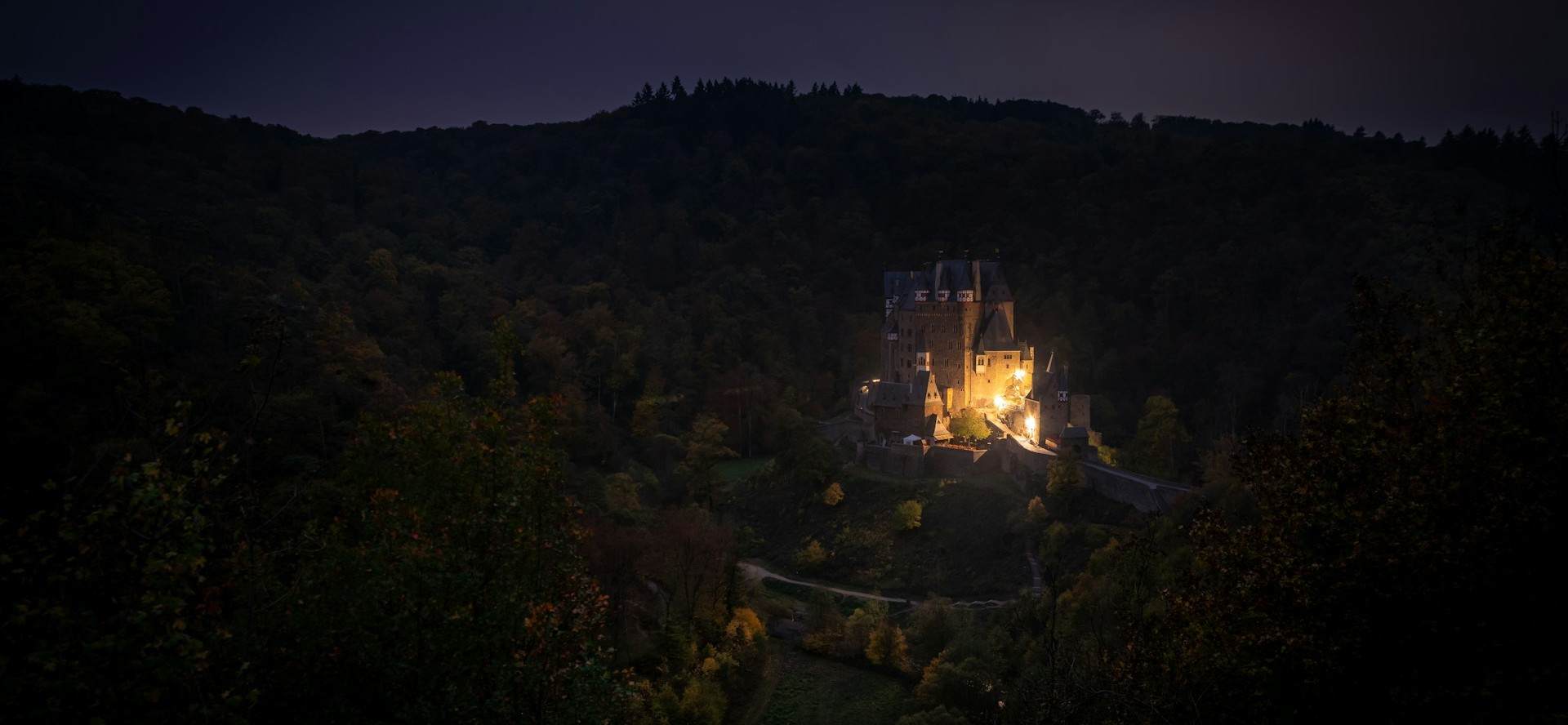Il trovatore
January 2026 | ||||||
|---|---|---|---|---|---|---|
Mo | Tu | We | Th | Fr | Sa | Su |
IL TROVATORE
Drama in four parts
Libretto by Salvadore Cammarano from the novel El trovador by Antonio García Gutiérrez
Music by Giuseppe Verdi
First performance Rome, Teatro Apollo, 19 January 1853
Synopsis
Place: Biscay and Aragon (Spain)
Time: Fifteenth century.
Act 1: The Duel
Scene 1: The guard room in the castle of Luna (The Palace of Aljafería, Zaragoza, Spain)
Ferrando, the captain of the guards, orders his men to keep watch while Count di Luna wanders restlessly beneath the windows of Leonora, lady-in-waiting to the Princess. Di Luna loves Leonora and is jealous of his successful rival, a troubadour whose identity he does not know. In order to keep the guards awake, Ferrando narrates the history of the count (Aria: Di due figli vivea padre beato / "The good Count di Luna lived happily, the father of two sons"): many years ago, a gypsy was wrongfully accused of having bewitched the youngest of the di Luna children; the child had fallen sick and for this the gypsy had been burnt alive as a witch, her protests of innocence ignored. Dying, she had commanded her daughter Azucena to avenge her, which she did by abducting the baby. Although the burnt bones of a child were found in the ashes of the pyre, the father refused to believe in his son's death; dying, he commanded his firstborn, the new Count di Luna, to seek Azucena.
Scene 2: Garden in the palace of the princess
Leonora confesses her love for the Troubadour to her confidante, Ines (Tacea la notte placida / "The peaceful night lay silent"... Di tale amor / "A love that words can scarcely describe"), in which she tells how she fell in love with a mystery knight, victor at a tournament: lost track of him when a civil war broke out: then encountered him again, in disguise as a wandering troubadour who sang beneath her window. When they have gone, Count di Luna enters, intending to pay court to Leonora himself, but hears the voice of his rival, in the distance: (Deserto sulla terra / "Alone upon this earth"). Leonora in the darkness briefly mistakes the count for her lover, until the Troubadour himself enters the garden, and she rushes to his arms. The Count challenges his rival to reveal his true identity, which he does: Manrico, a knight now outlawed and under death sentence for his allegiance to a rival prince. Manrico in turn challenges him to call the guards, but the Count regards this encounter as a personal rather than political matter, and challenges Manrico instead to a duel over their common love. Leonora tries to intervene, but cannot stop them from fighting (Trio: Di geloso amor sprezzato / "The fire of jealous love" ).
Act 2: The Gypsy Woman
Scene 1: The gypsies' camp
The gypsies sing the Anvil Chorus: Vedi le fosche notturne / "See! The endless sky casts off her sombre nightly garb...". Azucena, the daughter of the Gypsy burnt by the count, is still haunted by her duty to avenge her mother (Aria: Stride la vampa / "The flames are roaring!"). The Gypsies break camp while Azucena confesses to Manrico that after stealing the di Luna baby she had intended to burn the count's little son along with her mother, but overwhelmed by the screams and the gruesome scene of her mother's execution, she became confused and threw her own child into the flames instead (Aria:Condotta ell'era in ceppi / "They dragged her in bonds").
Manrico realises that he is not the son of Azucena, but loves her as if she were indeed his mother, as she has always been faithful and loving to him - and, indeed, saved his life only recently, discovering him left for dead on a battlefield after being caught in ambush. Manrico tells Azucena that he defeated di Luna in their earlier duel, but was held back from killing him by a mysterious power (Duet: Mal reggendo / "He was helpless under my savage attack"): and Azucena reproaches him for having stayed his hand then, especially since it was the Count's forces that defeated him in the subsequent battle of Pelilla. A messenger arrives and reports that Manrico's allies have taken Castle Castellor, which Manrico is ordered to hold in the name of his prince: and also that Leonora, who believes Manrico dead, is about to enter a convent and take the veil that night. Although Azucena tries to prevent him from leaving in his weak state (Ferma! Son io che parlo a te! / "I must talk to you"), Manrico rushes away to prevent her from carrying out this intent.
Scene 2: In front of the convent
Di Luna and his attendants intend to abduct Leonora and the Count sings of his love for her (Aria: Il balen del suo sorriso / "The light of her smile" ... Per me ora fatale / "Fatal hour of my life"). Leonora and the nuns appear in procession, but Manrico prevents di Luna from carrying out his plans and takes Leonora away with him, although once again leaving the Count behind unharmed, as the soldiers on both sides back down from bloodshed, the Count being held back by his own men.
Act 3: The Son of the Gypsy Woman
Scene 1: Di Luna's camp Di Luna and his army are attacking the fortress Castellor where Manrico has taken refuge with Leonora (Chorus:Or co' dadi ma fra poco / "Now we play at dice"). Ferrando drags in Azucena, who has been captured wandering near the camp. When she hears di Luna’s name, Azucena’s reactions arouse suspicion and Ferrando recognizes her as the supposed murderer of the count’s brother. Azucena cries out to her son Manrico to rescue her and the count realizes that he has the means to flush his enemy out of the fortress. He orders his men to build a pyre and burn Azucena before the walls.
Scene 2: A chamber in the castle
Inside the castle, Manrico and Leonora are preparing to be married. She is frightened; the battle with di Luna is imminent and Manrico’s forces are outnumbered. He assures her of his love (Aria, Manrico: Ah sì, ben mio, coll'essere / "Ah, yes, my love, in being yours"), even in the face of death. When news of Azucena’s capture reaches him, he summons his men and desperately prepares to attack (Stretta: Di quella pira l'orrendo foco / "The horrid flames of that pyre"). Leonora faints.
Act 4: The Punishment
Scene 1: Before the dungeon keep
Manrico has failed to free Azucena and has been imprisoned himself. Leonora attempts to free him (Aria: D'amor sull'ali rosee / "On the rosy wings of love"; Chorus & Duet:Miserere / "Lord, thy mercy on this soul") by begging di Luna for mercy and offers herself in place of her lover. She promises to give herself to the count, but secretly swallows poison from her ring in order to die before di Luna can possess her (Duet: Mira, d'acerbe lagrime / "See the bitter tears I shed").
Scene 2: In the dungeon
Manrico and Azucena are awaiting their execution. Manrico attempts to soothe Azucena, whose mind wanders to happier days in the mountains (Duet: Ai nostri monti ritorneremo / "Again to our mountains we shall return"). At last the gypsy slumbers. Leonora comes to Manrico and tells him that he is saved, begging him to escape. When he discovers she cannot accompany him, he refuses to leave his prison. He believes Leonora has betrayed him until he realizes that she has taken poison to remain true to him. As she dies in agony in Manrico's arms she confesses that she prefers to die with him than to marry another (Trio: Prima che d'altri vivere / "Rather than live as another's"). The count has heard Leonora's last words and orders Manrico's execution. Azucena awakes and tries to stop di Luna. Once Manrico is dead, she cries: Egli era tuo fratello! Sei vendicata, o madre. / "He was your brother ... You are avenged, oh mother!"
Program and cast
Conductor: Giampaolo Bisanti
Director: Marina Bianchi
Sets and costumes: Sofia Tasmagambetova and Pavel Dragunov
Fight director: Corrado Tomaselli
Lighting: Luciano Novelli
Principal characters and performers:
Count di Luna: Ariunbaatar Ganbaatar; Leon Kim (17, 22)
Leonora: Erika Grimaldi; Iwona Sobotka (17, 22)
Azucena: Clementine Margaine; Chiara Mogini (17, 22)
Manrico: Fabio Sartori; Samuele Simoncini (17, 22)
Ferrando: Simon Lim; Fabrizio Beggi (17, 22)
Ines: Irene Celle
Ruiz: Manuel Pierattelli
Orchestra, Chorus and Technicians of the Fondazione Teatro Carlo Felice di Genova
Chorus Master Claudio Marino Moretti
Production by the Fondazione Teatro Carlo Felice di Genova
The program is subject to change; please refer to official communications issued by the Organizer.
Carlo Felice Theater
Built on the area of Carlo Felice, the new theater, built by Aldo Rossi, recovers an idea already present in Paul Chessa projects and Carlo Scarpa: the creation of a piazza covered with 400 square meters, where the theater it was the ideal link between Galleria Mazzini and Piazza De Ferrari. Distant instead from an architectural point of view are the same Galleria Mazzini and the theater. the square is an open foyer; the walls are covered with stone slabs, and are enriched with columns and metal beams. There are two requirements that the architects wanted to keep in mind in the implementation of the new Carlo Felice theater: first, the need to rebuild it exactly where it was and secondly the desire to equip the new facility with the latest technology. From the latter need arises the imposing fly tower about 63 meters high. In practice the old theater work of Barabino remain the columns, the portico, the Latin inscription and the terrace that overlooks Via XXV Aprile which is accessed by one of the foyer; the current structure is very compact and geometric, the fly tower is a very linear in height developed rectangular, adorned only by a cornice.The auditorium, the foyer and services for the public are contained in a smaller box, where they emphasize the porch and the porch. As for the construction of the new theater are the stone were used for the exterior, plaster and iron, for the interior marble and wood. It is durable material that suggests an image of eternity, security and survival of the building over time. From the covered square, descending a staircase, you enter a room with a capacity of about 200 seats. Equipped with a small stage and independent from the rest of the theater, the hall hosts conferences, lectures and musical events. The interior of the theater entrance wide staircase leads to the closet and still climbing, the first foyer which has an area of 660 square meters and is decorated with frescoes and tapestries. the lantern A characteristic feature of the new Carlo Felice is the lantern visible in the foyer overlooking the lobby; it's a kind a light cone that runs through the building in all its height and it runs through all the plans, bringing the light from the roof to the indoor square. The tower Absolutely unique is the scenario in which they operate the technical units; right in the scenic tower, which houses the machine to move the shows, come together in a delicate balance human labor and sophisticated gear.In fact, the theater has four stages, a main stage, a back stage behind the first two stages and less aligned with each other and managed by integrated electronic and computerized. These scenic handling facilities, computerized lighting, sophisticated booths director for filming and acoustics among the best in Italy are among the features that make the Carlo Felice a factory of emotions among the most important in Italy.

 EN
EN DE
DE IT
IT FR
FR ES
ES RU
RU JP
JP RO
RO
 Seating plan
Seating plan 